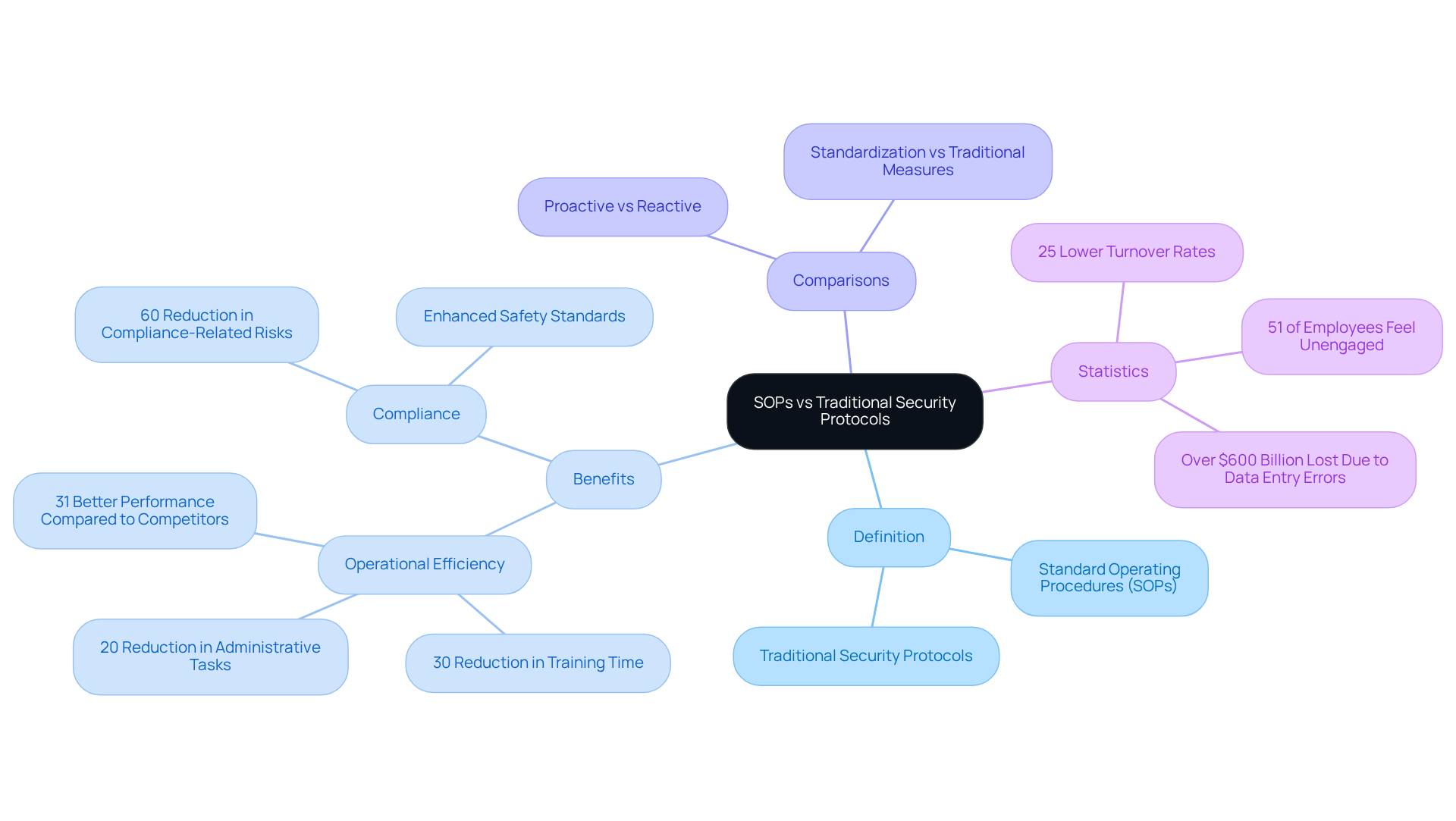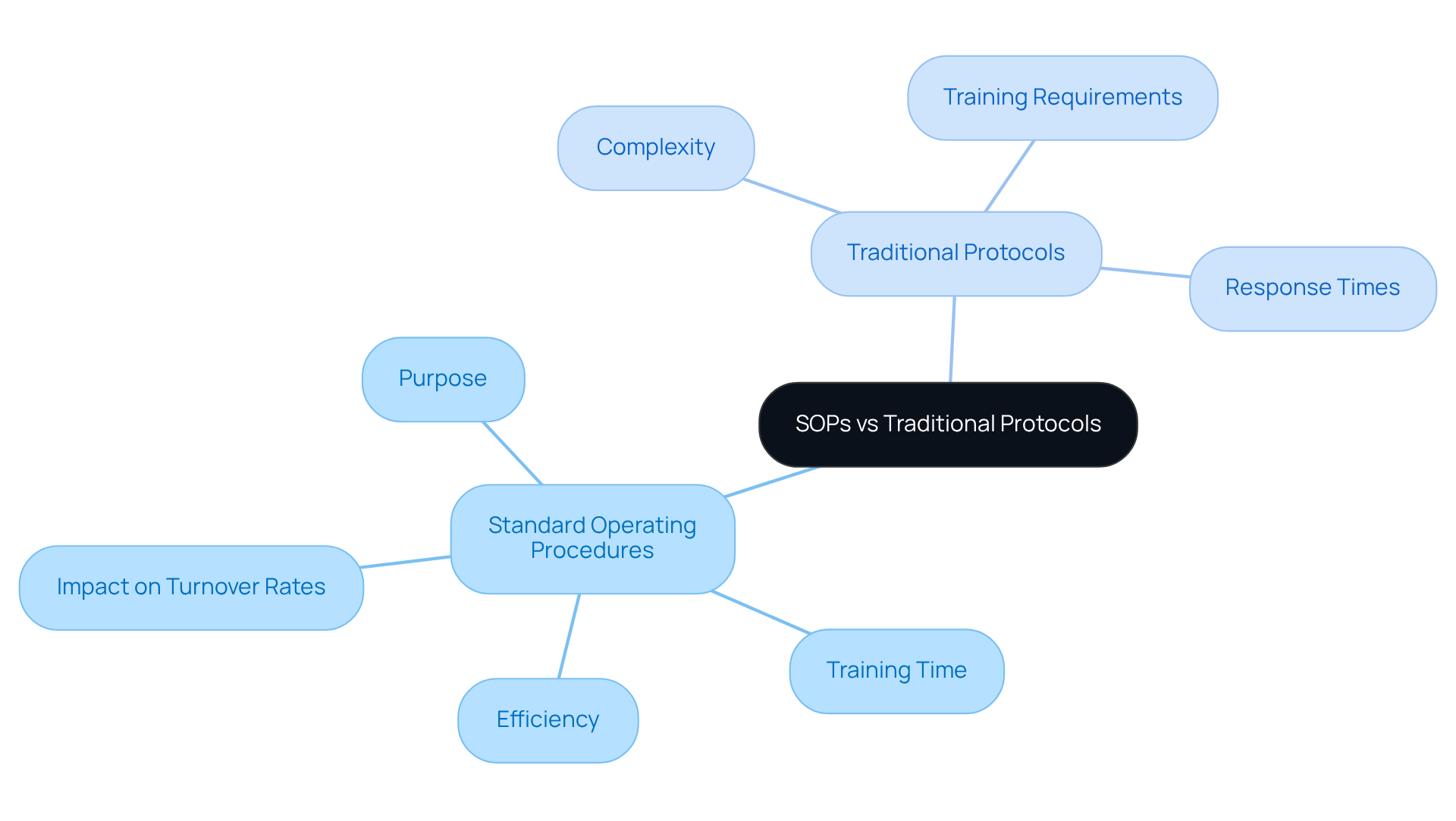
Automation and Documentation
|
November 12, 2025
|
SOP Cyber Security vs. Traditional Protocols: Key Differences Explained
Key Highlights:
- Standard Operating Procedures (SOPs) are detailed instructions for task execution, promoting consistency and compliance within organisations.
- Traditional security protocols focus on reactive measures to protect IT infrastructure but often lack a proactive approach.
- Implementing SOPs can lead to a 30% reduction in training time and a 20% decrease in administrative tasks.
- SOPs enhance compliance, with organisations reporting a 31% performance improvement and 25% lower turnover rates.
- SOPs simplify processes, making them easier for staff to follow compared to complex traditional security protocols.
- While SOPs boost operational efficiency, their rigidity may hinder creativity in fast-paced environments.
- Traditional security measures provide reliability but struggle with modern threats due to their reactive nature.
- SowFlow is an innovative tool that streamlines SOP documentation, enhancing efficiency and effectiveness in security management.
- Choosing between SOPs and traditional protocols depends on organisational goals, regulatory needs, and threat landscapes.
Introduction
You might be wondering, in this fast-paced world of cyber threats, what’s the best way for organizations to protect themselves? Should they stick with the old-school security protocols, or is it time to embrace the proactive vibe of Standard Operating Procedures (SOPs)? Traditional methods have been the go-to for ages, but let’s face it—they often struggle to keep up with the complexities of today’s risks.
So, what’s the deal with SOPs? This article dives into the key differences between SOP cyber security and those traditional protocols. We’ll explore how SOPs not only boost operational efficiency but also help with compliance and risk management. As organizations work hard to safeguard their assets, the big question lingers: can the structured approach of SOPs really outshine the reactive measures of traditional security systems when it comes to tackling today’s sophisticated cyber threats?
Let’s unpack this together!
Understanding SOPs and Traditional Security Protocols
You might be wondering what Standard Operating Procedures (SOPs) really are. Well, they’re basically detailed instructions that tell you how to get specific tasks done in an organization. Think of them as the playbook for consistency, quality, and compliance in various operations.
Now, on the flip side, we have conventional measures. These are the tried-and-true methods used to protect information and IT infrastructure from cyber threats. They include things like:
- Firewalls
- Intrusion detection systems
- Good old manual incident response strategies
While SOPs aim for operational efficiency and standardization, traditional security protocols often focus on reactive measures. Unfortunately, they sometimes miss the proactive approach that modern cybersecurity really needs.
Now, let’s talk about how executing these SOPs can seriously boost your operational efficiency. Did you know that organizations with organized procedures report an average 30% decrease in training time? That means new staff can get up to speed faster and more efficiently. Plus, by standardizing processes, employees can cut down on administrative tasks by up to 20%. That’s a win-win! Not only does this efficiency help prevent knowledge loss, but it also makes sure that essential procedures are documented and easy to access, even when employees transition in and out.
But wait, there’s more! The impact of SOPs goes beyond just efficiency; they’re also crucial for compliance, especially in industries that are heavily regulated. By standardizing operations, these procedures help organizations meet regulatory standards, which in turn boosts safety and compliance. Cybersecurity pros emphasize that weaving SOPs into your operational framework can lead to better risk management and a stronger organizational structure. Recent findings show that companies with clear procedures outperform their competitors by 31%. That’s a pretty big deal! And get this: organizations with efficient SOPs also report up to 25% lower turnover rates. Talk about a positive effect on employee engagement and retention!
In conclusion, while those conventional safety measures are super important for fending off cyber threats, the proactive nature of SOP cyber security makes it an essential tool for enhancing operational effectiveness and compliance in today’s fast-paced business world. So, why not take a closer look at how you can implement these procedures in your own organization?

Comparing Structure and Implementation of SOPs and Traditional Protocols
You might be wondering what Standard Operating Procedures (SOPs) are all about. Well, they’re like your trusty roadmap, laid out step-by-step to guide you through tasks. Each SOP usually covers the purpose, scope, responsibilities, and procedures, making it super easy to understand and follow. Now, compare that to traditional security protocols, which can feel like a jumbled mess of policies and guidelines. It’s no wonder they can be a bit tricky to apply!
When it comes to using SOPs, it’s pretty straightforward. They’re designed for quick application by staff, which really boosts operational efficiency. For example, organizations that have woven SOPs into their workflows often find that projects run smoother and deliverables are of higher quality. On the flip side, conventional protocols can demand a lot of training and a deep understanding of complex systems, which might slow down responses during security incidents. This difference in structure really shows how SOPs can simplify processes and lighten the load for employees, creating a more agile and responsive workplace.
And here’s something to think about: effective SOP implementation can actually cut down on training time compared to traditional methods. Data shows that companies using SOPs tend to have lower turnover rates. Why? Because they provide a solid foundation for training new hires, which helps keep things running smoothly. This efficiency not only minimizes risks related to knowledge gaps but also allows teams to work with greater confidence and clarity. So, it’s clear that SOP cyber security plays a crucial role in today’s operational landscape.

Evaluating Pros and Cons of SOPs vs. Traditional Security Protocols
You might be wondering about the benefits of Standard Operating Procedures (SOPs). Well, they offer some pretty significant advantages! Think about enhanced consistency, better training for new employees, and streamlined operations. All of these factors can really boost productivity. For instance, organizations that have set up SOPs often report productivity increases of up to 25%. Just look at a well-known automotive manufacturer that managed to cut down on production downtime significantly. Plus, SOPs help meet regulatory requirements by providing clear, actionable guidelines.
But here’s the catch: the rigidity of SOPs can sometimes stifle creativity and adaptability, especially in fast-paced environments where change is the name of the game. On the flip side, traditional security systems offer tried-and-true methods that bring a sense of reliability. However, they often struggle to tackle modern threats due to their reactive nature, which can lead to slow response times during incidents. The extensive documentation and approval processes can also slow things down, leaving organizations vulnerable to evolving cyber threats.
Recent studies show that while traditional protocols lay a solid foundation for protective measures, they often lack the agility needed to tackle today’s challenges. Experts emphasize that incorporating SOP cyber security into security frameworks can really boost organizational resilience, helping teams manage incidents quickly and effectively. And don’t forget, keeping those SOPs updated is crucial to ensure they stay relevant in our ever-changing business landscape.
Now, let’s talk about something exciting: SowFlow! It’s shaking things up in the documentation world, changing how teams create SOPs. Anastasia Masadi, a Product Owner, puts it perfectly:
- "SowFlow has been a game changer in the way we document work and deliver to our clients. I do not need to capture each screenshot individually, and do not even have to exit the browser while I am creating standard operating procedures and training materials. SowFlow gave me time from my life back."
How cool is that? This really highlights the time-saving features and efficiency boosts that SowFlow brings to SOP creation, making it a must-have for operations managers. By addressing the limitations of traditional protocols, SowFlow paves the way for a more proactive and adaptable approach to security management, ensuring organizations can respond effectively to modern challenges.

Assessing Suitability for Different Organizational Needs
You might be wondering about the best approach for your organization when it comes to SOP cyber security training and security protocols. If your focus is on operational efficiency, consistency, and simplicity, then standardized procedures could be just what you need. Think about industries like manufacturing, healthcare, and customer service—these sectors thrive on standardization, and implementing SOPs can really make a difference.
Now, let’s dive into a different scenario. If your organization operates in a heavily regulated environment or faces complex safety challenges, you might find that traditional safeguards are more your speed. For example, financial institutions and government bodies often require robust protective measures that only conventional systems can provide.
Ultimately, the choice between SOP cyber security measures and traditional security protocols boils down to your specific operational goals, regulatory needs, and the types of threats you’re dealing with. So, what’s your organization’s priority? It’s worth considering how each option aligns with your unique situation!

Conclusion
You might be wondering how SOP cyber security stacks up against traditional security protocols, right? Well, it turns out there’s a pretty significant shift happening in how organizations can boost their operational efficiency and manage risks. Traditional methods have been the go-to for ages, but the rise of SOPs shows us that a more proactive and structured approach is the way to go when it comes to protecting our information and infrastructure.
So, what’s the big deal about SOPs? For starters, they not only streamline processes and cut down on training time, but they also play a vital role in compliance and keeping employees engaged. On the flip side, while traditional protocols have their merits, they often struggle to keep up with the fast-paced world of modern cyber threats. The perks of SOPs—like better consistency and lower turnover rates—really highlight how they can shake up organizational practices for the better.
Ultimately, deciding whether to implement SOP cyber security measures or stick with traditional protocols boils down to what your organization truly needs and aims for. Embracing SOPs can pave the way for a more resilient and efficient operational framework, helping businesses tackle the complexities of today’s cyber landscape. So, take a moment to assess your priorities and think about how integrating SOPs could boost your security posture and overall performance. It’s definitely worth considering!
Frequently Asked Questions
What are Standard Operating Procedures (SOPs)?
Standard Operating Procedures (SOPs) are detailed instructions that guide individuals on how to perform specific tasks within an organization. They serve as a playbook for ensuring consistency, quality, and compliance in various operations.
What are traditional security protocols?
Traditional security protocols are conventional methods used to protect information and IT infrastructure from cyber threats. They include measures such as firewalls, intrusion detection systems, and manual incident response strategies.
How do SOPs improve operational efficiency?
Executing SOPs can lead to a significant boost in operational efficiency, with organizations reporting an average 30% decrease in training time for new staff and a reduction of up to 20% in administrative tasks due to standardized processes.
Why are SOPs important for compliance?
SOPs are crucial for compliance, especially in heavily regulated industries. By standardizing operations, they help organizations meet regulatory standards, thereby enhancing safety and compliance.
What benefits do organizations experience by implementing SOPs?
Organizations with clear SOPs can outperform their competitors by 31%, experience up to 25% lower turnover rates, and improve employee engagement and retention.
How do SOPs differ from traditional security measures?
While SOPs focus on proactive operational efficiency and standardization, traditional security measures tend to be more reactive, often lacking the proactive approach needed in modern cybersecurity.
What is the overall significance of SOPs in cybersecurity?
SOPs play an essential role in enhancing operational effectiveness and compliance in today's fast-paced business environment, making them a vital tool alongside conventional safety measures for managing cyber threats.
👍
What others are liking
5 Steps to outline your ideal documentation structure
5 MINS READ
Where to start the your journey of mapping out your ideal documentation structure, aligning it with the very heartbeat of your organization?
Defining a winning level of detail in your process
3 MINS READ
What is too much detail, and what is too little? This article described in that winning level detail about what detail is enough.





